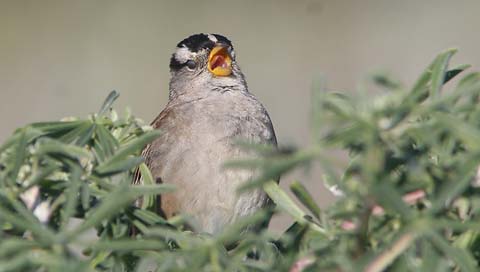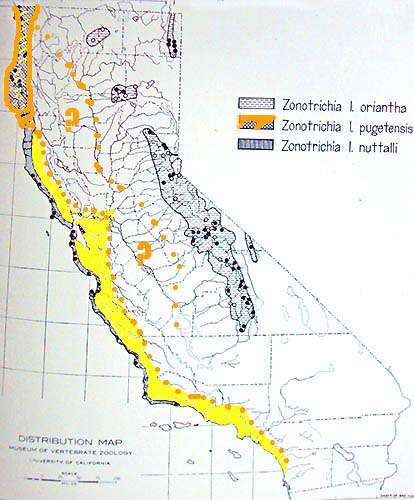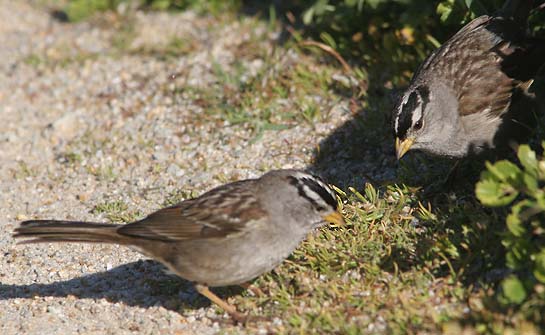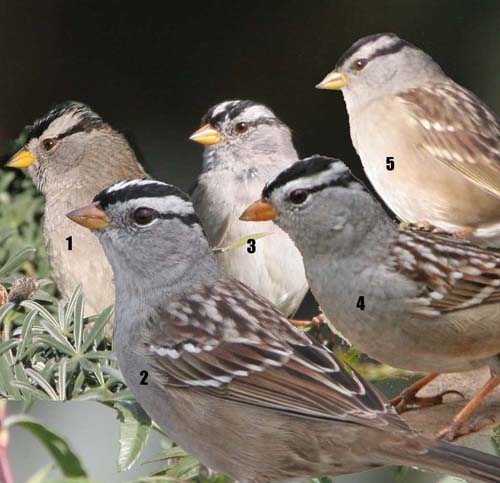a web page by Don Roberson |
||||
|
 |
|
Recognizing these important differences in distribution goes a long way towards learning how to identify the subspecies in the field. In spring and fall migration, though, there is more mixing among the groups. Nuttall's don't migrate so they are always right on the coast, but Puget Sound or Gambel's White-crowneds can be anywhere in MTY in migration. The geographic variation in White-crowned Sparrow has long been of substantial interest to ornithologists (e.g., Banks 1964). Comparative biology and migration of Pacific coastal White-crowneds were studied by Blanchard (1941), Blanchard (1942), and Mewaldt, Kibby & Morton (1968). Research on the biology of the species was summarized in Chilton et al. (1995). Local status and distribution is summarized in Roberson & Tenney (1993), Roberson (2002).
They also mentioned variation in the extent of dark on the bill (usually on the culmen) and in malar stripe, plus discussed a few other characters for first-year immatures or black-lored populations. Pyle (1997) added to identification criteria of birds in the hand. Geographic variation in the song of White-crowned Sparrows has been the subject of much focused research, including important papers by Austen & Handford (1991), Baptista (1975, 1977), Baptista et al. (1997), and DeWolfe & Baptista (1995). |
|
All but # 3 were taken in good full sunlight of well-lit birds; # 3 was in overcast conditions and brightened in a standard automatic way in PhotoShop. All birds essentially the same size — in creating the collage the front row birds were intentionally made slightly larger for perspective. |
|
|
|
Literature cited:
|


 This web project deals with adults. Fortunately, both sexes look more or less alike (right; mated pair of nuttalli
7 Apr 2010 Pacific Grove). The major paper on identification of
subspecies of White-crowned Sparrow, aimed at birders, is Dunn, Garrett
& Alderfer (1995). They dealt not only with the three subspecies
that reach coastal California, but also the two additional
'black-lored' subspecies from back East and in the western mountains.
As to our three races in coastal California, they proposed differences
for adult White-crowneds in:
This web project deals with adults. Fortunately, both sexes look more or less alike (right; mated pair of nuttalli
7 Apr 2010 Pacific Grove). The major paper on identification of
subspecies of White-crowned Sparrow, aimed at birders, is Dunn, Garrett
& Alderfer (1995). They dealt not only with the three subspecies
that reach coastal California, but also the two additional
'black-lored' subspecies from back East and in the western mountains.
As to our three races in coastal California, they proposed differences
for adult White-crowneds in: This
collage (right) attempts to compare the 3 subspecies that occur in
Monterey County, using both birds of 'known' identity or identified on
presumptive grounds. The birds are:
This
collage (right) attempts to compare the 3 subspecies that occur in
Monterey County, using both birds of 'known' identity or identified on
presumptive grounds. The birds are: